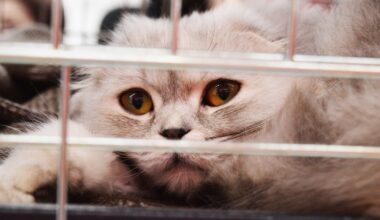How Medical Issues Can Cause Aggression in Cats
Understanding the roots of aggression in cats is essential for ensuring their well-being and maintaining a harmonious household environment. Many cat owners often overlook underlying medical issues as contributing factors to this behavior. A cat’s aggression can stem from both physical and psychological problems, making it vital to consult a veterinarian if aggressive behaviors arise. Various conditions can lead to irritability and aggressive responses, such as dental disease, arthritis, or hormonal imbalances. Pain, in particular, can trigger defensive or aggressive behavior, as the cat may associate discomfort with proximity to humans or other pets. Signs of medical issues may not always be apparent; therefore, regular check-ups become important. The role of stress cannot be dismissed either; anxiety due to changes in the environment can amplify aggression. Identifying these subtle cues is crucial. Moreover, a comprehensive understanding of a cat’s body language helps in deciphering the feline psyche. Prevention is also key; creating a safe environment and minimizing stressors can significantly reduce aggressive episodes. Supporting your cat through these medical challenges may foster healthy behavior patterns and improve their quality of life.
Identifying specific medical conditions that might cause aggression in cats can significantly aid in reducing unwanted behavior. One common issue is hyperthyroidism, which is often manifested through weight loss, increased appetite, and irritability. Cats suffering from this condition may exhibit aggressive tendencies due to heightened energy levels and irritability. Additionally, chronic pain from conditions like arthritis can lead to sudden aggression, especially during play. A cat might lash out if it feels tender in certain areas, and the pain alters its natural behavior. Urinary tract infections can also lead to aggression, as discomfort associated with urination may result in a cat guarding its litter box or becoming more defensive. Furthermore, neurological issues can manifest in aggressive behaviors, as they may impair a cat’s ability to socialize with humans or other animals. In such cases, appropriate medical intervention is crucial. The psychological impact of pain and discomfort shouldn’t be underestimated; it can affect a cat’s demeanor. So, observing your cat’s behavior changes closely is essential, as a proactive rather than reactive approach can lead to a better understanding of your feline’s aggression.
The Importance of Veterinary Consultation
Regular veterinary check-ups play a critical role in identifying potential health issues before they worsen. A thorough physical examination can reveal underlying conditions contributing to aggressive behavior. By fostering an open line of communication with a veterinarian, cat owners should discuss behavioral changes and consult about any sudden or unusual aggression. Vets may recommend various diagnostic tests, including blood work or urinalysis, to ascertain the health of your cat. Understanding the health status helps develop a targeted treatment plan, thus possibly increasing successful outcomes. Moreover, medications or alternative therapies may be prescribed depending on the underlying cause of aggression. Moreover, many times, medical treatment may involve behavior modification strategies that can help reduce aggression. Owners should work closely with professionals and explore all options available. Nutritional adjustments can also play an important part in managing aggression stemming from medical issues. A sensitive approach ensures your vet can tailor the best plan for your cat’s condition, which is beneficial for your pet’s well-being. Assessment of environmental triggers is equally crucial to creating a conducive home atmosphere for your feline friend.
Recognizing signs of discomfort or medical issues is another essential step toward solving aggression problems in cats. Each time a cat exhibits signs of distress, be it vocalizations, hissing, or sudden withdrawal, owners must pay close attention. Small behavioral changes may seem insignificant at first, but they can indicate underlying health problems that may escalate. Furthermore, cats often mask their pain until it becomes severe, so being observant after any changes is paramount. For example, changes in grooming habits might signal dental pain or other health issues. Regular grooming sessions provide an opportunity for owners to spot any irregularities. Additionally, changes in appetite, sleeping patterns, or litter box behaviors can be essential indicators. Failing to recognize these signals may lead to a worsening of aggression and stress, both for the cat and the household. Owners should note that all behaviors stem from some emotional or psychological basis, which often relates back to pain or discomfort. A proactive approach in monitoring these behaviors gives a clear picture of the cat’s well-being, allowing for timely veterinary intervention when necessary. Documenting these observations can help enhance communication with the veterinarian.
Creating a Stress-Free Environment
Beyond medical concerns, creating a comfortable living space for your cat can help alleviate stress-associated aggression. A stress-free environment can incorporate various elements, such as vertically enriching spaces like cat trees and shelves, allowing your feline friend to observe their surroundings from a comfortable height. Moreover, maintaining a clean and safe litter area is vital for encouraging appropriate elimination behaviors. Providing multiple resting places and hiding spots can give your cat a sense of security, reducing anxiety and potential defensive aggression. This environment also allows cats to retreat when feeling threatened, and it minimizes competition over resources among multiple pets. Establishing effective feeding routines can further combat food-related aggression. Providing separate feeding areas or utilizing puzzle feeders can mitigate competition. Social interaction should be balanced, understanding that some cats prefer less exposure to human interaction than others. Techniques such as gradual introductions might also be effective in fostering healthier relationships. Furthermore, the use of calming products, such as pheromone diffusers, can further comfort cats. All these factors combined contribute to a secure environment that encourages appropriate behaviors and reduces incidents of aggression.
Behavioral therapy may significantly assist in addressing aggressive tendencies in cats, especially when underlying medical issues are diagnosed and treated. Working with animal behaviorists can offer valuable insights into your cat’s behavior. Such professionals can tailor training techniques specifically to your cat’s personality traits, facilitating a more relaxed demeanor. Employing positive reinforcement strategies is often crucial; rewarding desired behaviors rather than focusing solely on corrections fosters a positive learning atmosphere. This approach can help cats learn acceptable ways to express dissatisfaction or discomfort, thereby reducing hostility. Moreover, introducing interactive playtime with positive reinforcement can bond owners and cats while presenting mental stimulation opportunities. Personalized training sessions can also guide owners in understanding feline communication, such as body language. Admission of frustration through play can divert energy away from defensive aggression. Additionally, utilizing various enrichment tools, such as scratching posts and toys, can provide healthy outlets for a cat’s energy. These changes, in conjunction with addressing medical issues and environmental stress, can create a comprehensive approach to managing aggressive behavior. Long-lasting results come with dedicated commitment to addressing both physical and emotional needs.
Conclusion: A Holistic Approach to Cat Aggression
A comprehensive understanding of aggression in cats combines medical insight, behavioral strategies, and environmental adjustments. Consulting a veterinarian remains critical, as they can diagnose any underlying conditions responsible for this behavior. Combining treatments for medical issues with behavioral strategies creates a therapy plan suited for your cat. Active engagement in observing behavioral cues helps owners take proactive measures. With awareness of both physical and psychological aspects, targeted interventions can be employed to tackle aggressive tendencies effectively. Moreover, a well-structured training program not only strengthens the bond between owner and cat but also promotes positive behavioral changes. The integration of environmental enrichment can further reduce aggression, contributing to a sense of security for the cat. Individuals fostering a supportive environment enable overall improvement in a cat’s quality of life. Since aggressive encounters can lead to unnecessary stress for owners and pets alike, taking steps to address this issue holistically is imperative. Each cat is unique in its responses, emphasizing a tailored strategy. Nurturing a calm and understanding environment allows both owners and cats to enjoy a peaceful coexistence.
The journey to understanding cat aggression is nuanced, requiring effort from cat owners. Emphasizing proper medical care and attentive observation can pave the path for effective solutions. With mutual trust and respect, owners can promote happier existences for their cats.


